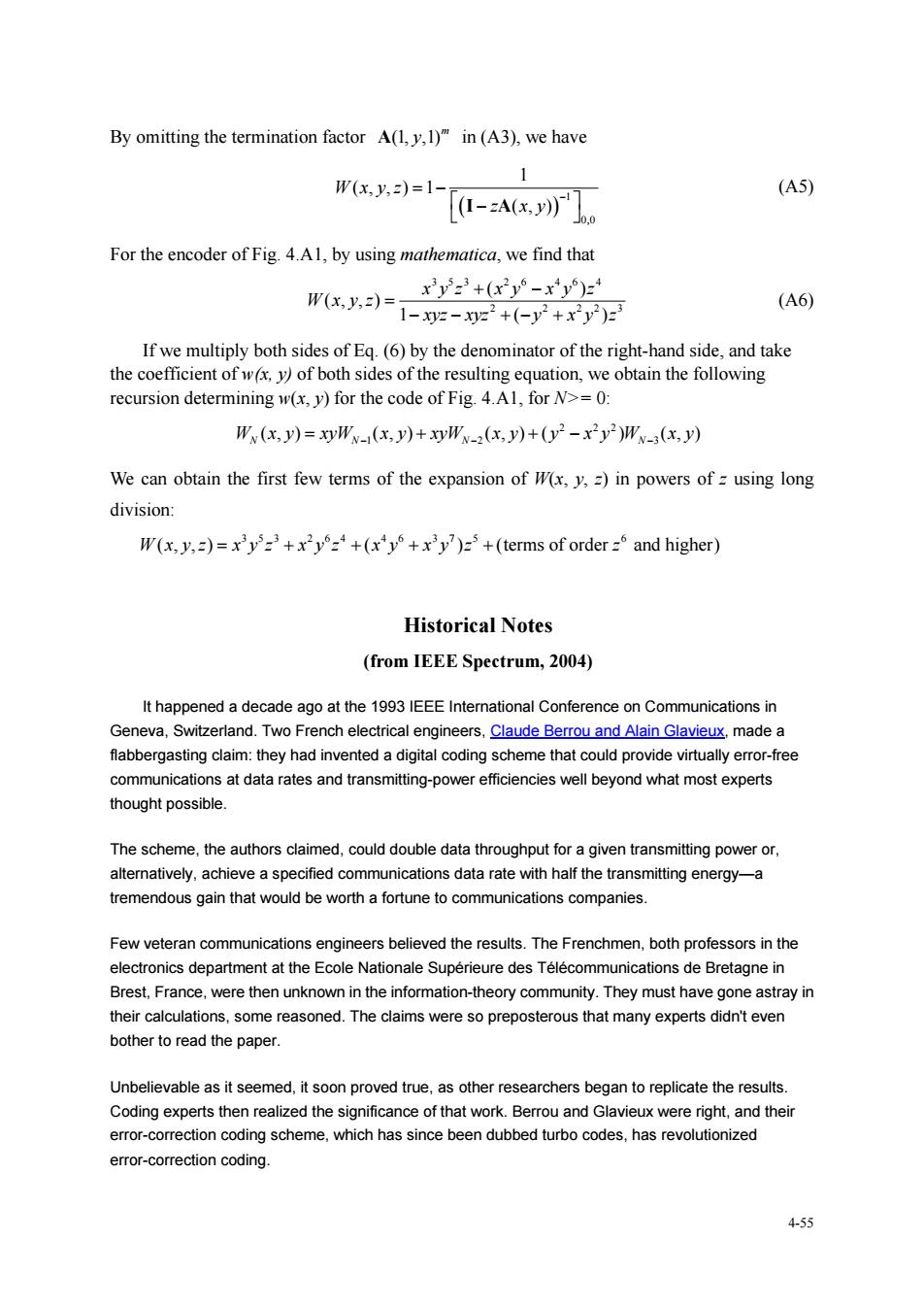正在加载图片...

By omitting the termination factor A(Ly,1)"in(A3),we have W(x,y,)=1- -Ax,。 (A5) For the encoder of Fig.4.Al,by using mathematica.we find that xy+(x2y-x wx)=1-02-+(y+x)F (A6) If we recursion determining w(x,y)for the code of Fig.4.Al,for N>=0: Wy(x.y)=xyWv-(x.y)+xWv_2(x.y)+(y2-x'y2v(x.y) We can obtain the first few terms of the expansion of W(x,y,=in powers of=using long division: W(x,y,=)=x+x+(x+xy )+(terms of order and higher) Historical Notes (from IEEE Spectrum,2004) It happened a decadeago at the 1993 Conferenceon Communications in Geneva,Switzerland.Two French electrical engineers,Claude Berrou and Alain Glavieux,made a flabbergasting claim:they had invented a digital coding scheme that could provide virtually error-free communications at data rates and transmitting-power efficiencies well beyond what most experts thought possible. The scheme.claimed,cou double data ut for a a given transmiting powero altematively.achieve a specified communications data rate with half the transmitting eergy-a tremendous gain that would be worth a fortune to communications companies. Few veteran communications engineers believed the results.The Frenchmen.both professors in the electronics department at the Ecole Nationale Superieure des Telecommunications de Bretagne in Brest.France.were then unknown in the information-theory community.They must have gone astray in their caculations.some reasoned.The claims were sopreposterous that many experts didn't even bother to read the paper Unbelievable as it seemed,it soon proved true.as other researchers began to replicate the results. Coding experts then realized the significance of that work.Berrou and Glavieux were right,and their error-correction coding scheme.which has since been dubbed turbo codes.has revolutionized error-correction coding 4-55 4-55 By omitting the termination factor (1, ,1)m A y in (A3), we have 1 0,0 1 (, ,) 1 (, ) Wxyz z xy I A (A5) For the encoder of Fig. 4.A1, by using mathematica, we find that 3 53 2 6 4 6 4 2 2 22 3 ( ) (, ,) 1 () xyz xy xy z Wxyz xyz xyz y x y z (A6) If we multiply both sides of Eq. (6) by the denominator of the right-hand side, and take the coefficient of w(x, y) of both sides of the resulting equation, we obtain the following recursion determining w(x, y) for the code of Fig. 4.A1, for N>= 0: 2 22 12 3 (, ) (, ) (, ) ( ) (, ) W x y xyW x y xyW x y y x y W x y NN N N We can obtain the first few terms of the expansion of W(x, y, z) in powers of z using long division: 3 53 2 64 4 6 3 7 5 6 W xyz xyz xyz xy xy z z ( , , ) ( ) (terms of order and higher) Historical Notes (from IEEE Spectrum, 2004) It happened a decade ago at the 1993 IEEE International Conference on Communications in Geneva, Switzerland. Two French electrical engineers, Claude Berrou and Alain Glavieux, made a flabbergasting claim: they had invented a digital coding scheme that could provide virtually error-free communications at data rates and transmitting-power efficiencies well beyond what most experts thought possible. The scheme, the authors claimed, could double data throughput for a given transmitting power or, alternatively, achieve a specified communications data rate with half the transmitting energy—a tremendous gain that would be worth a fortune to communications companies. Few veteran communications engineers believed the results. The Frenchmen, both professors in the electronics department at the Ecole Nationale Supérieure des Télécommunications de Bretagne in Brest, France, were then unknown in the information-theory community. They must have gone astray in their calculations, some reasoned. The claims were so preposterous that many experts didn't even bother to read the paper. Unbelievable as it seemed, it soon proved true, as other researchers began to replicate the results. Coding experts then realized the significance of that work. Berrou and Glavieux were right, and their error-correction coding scheme, which has since been dubbed turbo codes, has revolutionized error-correction coding